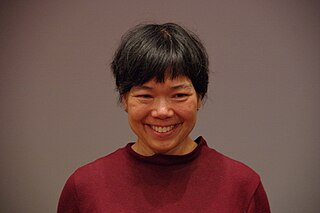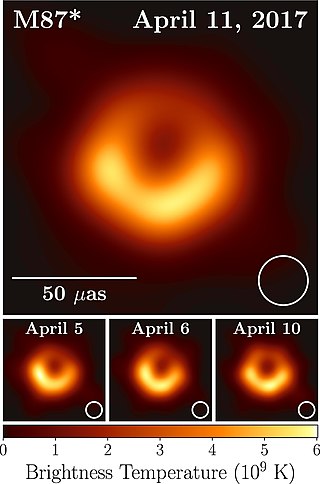
Sandra Moore Faber is an American astrophysicist known for her research on the evolution of galaxies. She is the University Professor of Astronomy and Astrophysics at the University of California, Santa Cruz, and works at the Lick Observatory. She has made discoveries linking the brightness of galaxies to the speed of stars within them and was the co-discoverer of the Faber–Jackson relation. Faber was also instrumental in designing the Keck telescopes in Hawaii.
Marc Aaronson was an American astronomer.

Jane X. Luu is a Vietnamese-American astronomer and defense systems engineer. She was awarded the Kavli Prize for 2012 "for discovering and characterizing the Kuiper Belt and its largest members, work that led to a major advance in the understanding of the history of our planetary system".
Donald Edward Osterbrock was an American astronomer, best known for his work on star formation and on the history of astronomy.

Geoffrey William Marcy is an American astronomer. He was an early influence in the field of exoplanet detection, discovery, and characterization. Marcy was a professor of astronomy at the University of California, Berkeley, and an adjunct professor of physics and astronomy at San Francisco State University. Marcy and his research teams discovered many extrasolar planets, including 70 out of the first 100 known exoplanets and also the first planetary system around a Sun-like star, Upsilon Andromedae. Marcy was a co-investigator on the NASA Kepler mission. His collaborators have included R. Paul Butler, Debra Fischer and Steven S. Vogt, Jason Wright, Andrew Howard, Katie Peek, John Johnson, Erik Petigura, Lauren Weiss, Lea Hirsch and the Kepler Science Team. Following an investigation for sexual harassment in 2015, Marcy resigned his position at the University of California, Berkeley.

Bryan Malcolm Gaensler is an Australian astronomer based at the University of California, Santa Cruz. He studies magnetars, supernova remnants, and magnetic fields. In 2014, he was appointed as Director of the Dunlap Institute for Astronomy & Astrophysics at the University of Toronto, after James R. Graham's departure. He was the co-chair of the Canadian 2020 Long Range Plan Committee with Pauline Barmby. In 2023, he was appointed as Dean of Physical and Biological Sciences at UC Santa Cruz.

Robert P. Kirshner is an American astronomer, Chief Program Officer for Science for the Gordon and Betty Moore Foundation, and the Clownes Research Professor of Science at Harvard University. Kirshner has worked in several areas of astronomy including the physics of supernovae, supernova remnants, the large-scale structure of the cosmos, and the use of supernovae to measure the expansion of the universe.

Alexei Vladimir "Alex" Filippenko is an American astrophysicist and professor of astronomy at the University of California, Berkeley. Filippenko graduated from Dos Pueblos High School in Goleta, California. He received a Bachelor of Arts in physics from the University of California, Santa Barbara in 1979 and a Ph.D. in astronomy from the California Institute of Technology in 1984, where he was a Hertz Foundation Fellow. He was a postdoctoral Miller Fellow at Berkeley from 1984 to 1986 and was appointed to Berkeley's faculty in 1986. In 1996 and 2005, he a Miller Research Professor, and he is currently a Senior Miller Fellow. His research focuses on supernovae and active galaxies at optical, ultraviolet, and near-infrared wavelengths, as well as on black holes, gamma-ray bursts, and the expansion of the Universe.

Feryal Özel is a Turkish-American astrophysicist born in Istanbul, Turkey, specializing in the physics of compact objects and high energy astrophysical phenomena. As of 2022, Özel is the Department Chair and a professor at the Georgia Institute of Technology School of Physics in Atlanta. She was previously a professor at the University of Arizona in Tucson, in the Astronomy Department and Steward Observatory.
Jerry Earl Nelson was an American astronomer known for his pioneering work designing segmented mirror telescopes, which led to him sharing the 2010 Kavli Prize for Astrophysics.

Steven Scott Vogt is an American astronomer of German descent whose main interest is the search for extrasolar planets.
Rachel S. Somerville is an American astronomer and holds the George A. and Margaret M. Downsbrough Chair in Astrophysics at Rutgers University. She is known for theoretical research into galaxy formation and evolution. She was awarded the 2013 Dannie Heineman Prize for Astrophysics “For providing fundamental insights into galaxy formation and evolution using semi-analytic modeling, simulations and observations.”

John Asher Johnson is an American astrophysicist and professor of astronomy at Harvard. He is the first tenured African-American physical science professor in the history of the university. Johnson is well known for discovering three of the first known planets smaller than the Earth outside of the solar system, including the first Mars-sized exoplanet.

Claudia Megan Urry is an American astrophysicist, who has served as the President of the American Astronomical Society, as chair of the Department of Physics at Yale University, and as part of the Hubble Space Telescope faculty. She is currently the Israel Munson Professor of Physics and Astronomy at Yale University and Director of the Yale Center for Astronomy and Astrophysics. Urry is notable not only for her contributions to astronomy and astrophysics, including work on black holes and multiwavelength surveys, but also for her work addressing sexism and sex equality in astronomy, science, and academia more generally.

Natalie M. Batalha is professor of Astronomy and Astrophysics at UC Santa Cruz. Previously she was a research astronomer in the Space Sciences Division of NASA Ames Research Center and held the position of Co-Investigator and Kepler Mission Scientist on the Kepler Mission, the first mission capable of finding Earth-size planets around other stars.

Elena Aprile is an Italian-American experimental particle physicist. She has been a professor of physics at Columbia University since 1986. She is the founder and spokesperson of the XENON Dark Matter Experiment. Aprile is well known for her work with noble liquid detectors and for her contributions to particle astrophysics in the search for dark matter.

Joan T. Schmelz is the Associate Director for Science and Public Outreach at the Stratospheric Observatory for Infrared Astronomy (SOFIA) for the Universities Space Research Association (USRA). Previously, Schmelz was the Deputy Director of Arecibo Observatory and the Director of USRA Operations at Arecibo from 2015 through 2018. Before joining USRA, Schmelz was an NSF Program Director in the Astronomical Sciences Division, where she oversaw the Astronomy & Astrophysics Postdoctoral Fellowship program, and a professor of physics at the University of Memphis from 1996 to 2017. Schmelz's research focus is heliophysics, specifically investigating the coronal heating problem as well as the properties and dynamics of the solar atmosphere. She uses spectroscopic and image data in the X-ray and ultraviolet wavelength ranges obtained from NASA satellites and rockets. She has published over 80 refereed scientific journal articles and authored three books.

Sarah Ballard is an American astronomer who is a professor at the University of Florida. She has been a Torres Fellow at the Massachusetts Institute of Technology, a L'Oreal Fellow, and a NASA Carl Sagan Fellow.
Nia Imara is an American astrophysicist, artist, and activist. Imara's scientific work deals with galactic mass, star formation, and exoplanet detection. Imara was the first African-American woman to earn a PhD in astrophysics at the University of California, Berkeley and was the inaugural postdoctoral fellow in the Future Faculty Leaders program at Harvard University. In 2020, Imara joined the University of California, Santa Cruz as an assistant professor in the Department of Astronomy.
Ann I. Zabludoff is an American astronomer and astrophysicist whose research has included galaxy clusters and the effects of galactic environments on star formation, and the use of gravitational lenses to study the formation and interaction of the earliest galaxies, including observations with the Magellan Telescopes and Hubble Space Telescope. She is a professor of astronomy, astrophysics, and cosmology at the University of Arizona.














